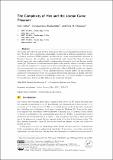| dc.contributor.author | Adler, Aviv | |
| dc.contributor.author | Daskalakis, Konstantinos | |
| dc.contributor.author | Demaine, Erik D | |
| dc.date.accessioned | 2017-07-25T18:31:42Z | |
| dc.date.available | 2017-07-25T18:31:42Z | |
| dc.date.issued | 2016-07 | |
| dc.identifier.isbn | 978-3-95977-013-2 | |
| dc.identifier.issn | 1868-8969 | |
| dc.identifier.other | Track A: Algorithms, Complexity and Games | |
| dc.identifier.other | Article no.24 | |
| dc.identifier.uri | http://hdl.handle.net/1721.1/110842 | |
| dc.description.abstract | The Jordan curve theorem and Brouwer's fixed-point theorem are fundamental problems in topology. We study their computational relationship, showing that a stylized computational version of Jordan’s theorem is PPAD-complete, and therefore in a sense computationally equivalent to Brouwer’s theorem. As a corollary, our computational result implies that these two theorems directly imply each other mathematically, complementing Maehara's proof that Brouwer implies Jordan [Maehara, 1984]. We then turn to the combinatorial game of Hex which is related to Jordan's theorem, and where the existence of a winner can be used to show Brouwer's theorem [Gale,1979]. We establish that determining who won an (implicitly encoded) play of Hex is PSPACE-complete by adapting a reduction (due to Goldberg [Goldberg,2015]) from Quantified Boolean Formula (QBF). As this problem is analogous to evaluating the output of a canonical path-following algorithm for finding a Brouwer fixed point - and which is known to be PSPACE-complete [Goldberg/Papadimitriou/Savani, 2013] - we thereby establish a connection between Brouwer, Jordan and Hex higher in the complexity hierarchy. | en_US |
| dc.description.sponsorship | National Science Foundation (U.S.) (NSF grant CCF-1551875) | en_US |
| dc.description.sponsorship | United States. Office of Naval Research (ONR grant N00014-12-1-0999) | en_US |
| dc.language.iso | en_US | |
| dc.publisher | Schloss Dagstuhl, Leibniz-Zentrum für Informatik GmbH | en_US |
| dc.relation.isversionof | http://dx.doi.org/10.4230/LIPIcs.ICALP.2016.24 | en_US |
| dc.rights | Creative Commons Attribution 4.0 International License | en_US |
| dc.rights.uri | http://creativecommons.org/licenses/by/4.0/ | en_US |
| dc.source | Dagstuhl Publishing | en_US |
| dc.title | The Complexity of Hex and the Jordan Curve Theorem | en_US |
| dc.type | Article | en_US |
| dc.identifier.citation | Adler, Aviv, Constantinos Daskalakis, and Erik Demaine. "The Complexity of Hex and the Jordan Curve Theorem" In 43rd International Colloquium on Automata, Languages, and Programming: ICALP 2016, Rome, Italy, July 12-15, 2016. Article no. 24; pp. 24:1-24:14. | en_US |
| dc.contributor.department | Massachusetts Institute of Technology. Computer Science and Artificial Intelligence Laboratory | en_US |
| dc.contributor.department | Massachusetts Institute of Technology. Department of Electrical Engineering and Computer Science | en_US |
| dc.contributor.mitauthor | Adler, Aviv | |
| dc.contributor.mitauthor | Daskalakis, Konstantinos | |
| dc.contributor.mitauthor | Demaine, Erik D | |
| dc.relation.journal | 43rd International Colloquium on Automata, Languages, and Programming (ICALP 2016) | en_US |
| dc.eprint.version | Final published version | en_US |
| dc.type.uri | http://purl.org/eprint/type/ConferencePaper | en_US |
| eprint.status | http://purl.org/eprint/status/NonPeerReviewed | en_US |
| dspace.orderedauthors | Adler, Aviv; Daskalakis, Constantinos; Demaine, Erik | en_US |
| dspace.embargo.terms | N | en_US |
| dc.identifier.orcid | https://orcid.org/0000-0003-3698-7639 | |
| dc.identifier.orcid | https://orcid.org/0000-0002-5451-0490 | |
| dc.identifier.orcid | https://orcid.org/0000-0003-3803-5703 | |
| mit.license | PUBLISHER_CC | en_US |
